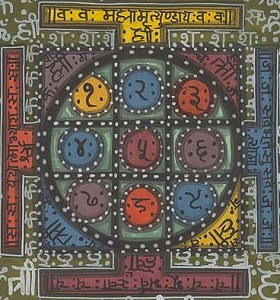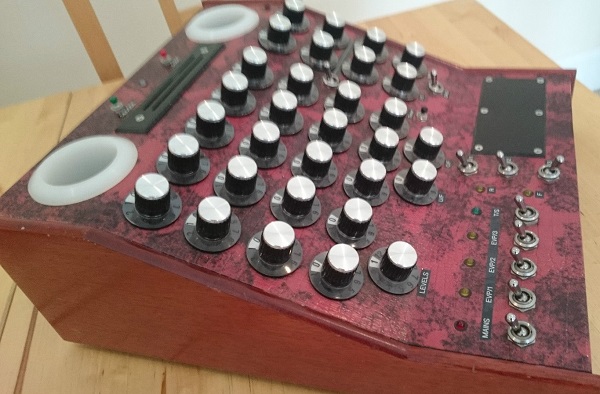A sequence of numbers known as “Rates” is commonly used with radionics instruments. A Rate is a pattern that may represent a specific condition, situation, manifestation, object or environment. As it is understood, a Rate resonates through all levels of being, from the aether (or akasha) through the different planes of existence to the gross material plane.

A number is a symbol or representation of – for example – a level, potential, dimension or frequency. A number (the Rate) may therefore form a mental structure that is intended to resonate with what we wish to access in the information field (aether or akasha).
Base 10 Rates (for which the dials are numbered from 0 to 10) are common on instruments that utilise variable resistors (potentiometers). George De La Warr and Bruce Copen are two well known radionics constructors that used these Rates. Malcolm Rae developed a Base 44 system which enables finer tuning and greater accuracy, beneficial when treating aetheric, mental and subtle levels.
The design by Galen Hieronymus uses two variable capacitors. The dials are numbered from 0 to 100, and together with the air capacitors they offer precise tuning.
At the physical level there are further aspects of radionic Rates that may be taken into consideration. In addition to the numbers or digits of the Rate, there are also the angles of the dial rotation and resistance/capacitance (depending upon the design of the instrument), all of which together create a multidimensional pattern.
There is more within the array of Rates dials than simply total resistance (for this discussion I will focus on potentiometers). Total resistance is part of, but not the whole picture. Imagine a potentiometer with its wiper in a certain position on the carbon (or wirewound) semicircular track. It creates a local pattern, complete in itself. But when considered together with the other potentiometers in the dial bank, a more complex pattern has been created. This pattern that has thus been created is a physical representation, a symbol, that resonates at a subtle level with the energetic information field that we intend to stimulate, or simulate.

The actual resistance and/or capacitance of the dials affect the resonant frequency of the circuit of the instrument. Nevertheless the individual resistance of each dial in relation to the whole is more important than total resistance, from the perspective of creating an informational pattern. I consider the electronic function of the potentiometers of lesser importance than the pattern created by the Rate.
If imagined superimposed over each other, the dial angles form a resonant pattern in the aether. This has a correspondence with the geometric symbol cards created by Malcolm Rae for his remedy simulators and other radionic instruments.
This collective radionic pattern is comparable to a mandala or yantra, both of which are devices used in Eastern spiritual traditions. These symbols may be understood to possess or manipulate conscious energy.
The creation of a mandala (a metaphysical circular symbol) is a meditative process that brings about a transformation of consciousness. A yantra is a grid or pattern (a “machine”) designed to process energy with the purpose of harmonising or focusing specific subtle energies.

A radionic instrument is a physical device with a subtle purpose – a machine that functions through intention. A machine is useless without the human element; it is nothing on its own. Its purpose is to enhance the abilities of the human. Numbers are a way in which the operator can interact with the machine.
Because of the intention of the constructor and the operator, the instrument therefore possesses Purpose. As the instrument is designed with a purpose, those who consciously interact with it empower the instrument to fulfill its purpose.
The purpose of a radionics instrument is to access, amplify and remedy a situation or condition by referencing and resonating with energetic or vibrational information that is at the origin of manifestation. The operator brings to the instrument specific vibrational or energetic information in the form of his or her intention, and will fine tune the instrument to resonate with that intention, as it relates to a situation or substance, by means of the dials.

Tuning the instrument by using the numbered Rates dials serves to focus and engage the whole mind. The rational, linear Yang mind of the left brain is focused by the tuning of the dials, and the creative, holistic Yin mind of the right brain is engaged in following through with the intention. If the instrument is set up and left functioning, the subconscious mind may remain in resonance with the intention embodied in the tuning, in effect amplifying the energy directed towards the desired outcome.
Another way to view the function of the dials is that they produce, symbolically or otherwise, a kind of tension, just as a string on a musical instrument is tuned by the tuning gear or peg. In the case of the radionics instrument, the dials resonate with intention or situation. Just as a vibration occurs in a string that is tuned to the same frequency as a tone produced nearby, so the dial array, tuned with the mental focus of the operator, resonates with information in the ever present aether. This is sympathetic resonance, a balancing of the vibratory information field.
The use of Rates specifically enables the radionics operator to analyse and treat such things as medical conditions, the subtle bodies, agriculture and pests, and to create vibrational medicines such as homeopathic remedies and essences.



I am also manufacturer of these types of machines. I salute you for your deep knowledge in Radionics
Love this article
It is so well expressed
I enjoy your clarity and bringing in the ancient radionic like methods of yantra and two brains in accessing subtle levels of being
and of course mantra is included by inference
There are many stories in India which underline that a mantra given with intention to a soul by a true master has huge power but the same words found in a book are lustreless and lack that power
Thanks for sharing Geoff
Do another article if you can .. you have a gift of explaining…
WE BOUGHT A COMPANY FROM DR.W HOFFMAN MANY YEARS AGO. WE HAVE A LOT OF OUR HOLISTIC CARDS. BUT SOME HAVE BEEN LOST OVER THE YEARS AND I’M LOOKING TO SEE IF THEY ARE STILL AVAILABLE.
Hi Amy, the people at Magneto Geometric Applications should be able to help. http://www.magnetogeometrics.co.uk
Hi, Thank you for your insight. I gathered from your article the importance of not just the value of the dial but also the position (i.e. pattern). This makes me wonder about the digital radionic instruments in the market today with neither physical dials nor graphical representation of one. They generate rates basically by various encoding algorithm which in turn generates different frequencies/colours/etc.
My question is, do you think the effectiveness of rates is lost in this type of digital instruments? Thank you.
Digital radionics instruments often make use of random number generators which are directly influenced by the intention of the operator and certainly seem to be effective. However there are other modalities too, even those that use rates in numerical form. Numbers are also patterns and ratios. Digital radionics instruments have their adherents, and many prefer them over analogue-type instruments.
Analysis in digital radionics is faster (not necessarily more accurate). One big advantage is that you can recognize patterns between different analysis sessions. The software can be programmed in a way, that these patterns are highlighted. For example the reoccurrence of specific rates is of great interest for the operator.
I have heard several people criticize these digital instruments and their random number generators. They say the analysis results are random and not consistent. Run the anlylisis once and the person has adrenal fatigue, run it again right away and they have legionairrs disease. I have no experience with these devices. Do you or anyone else have any insights on this?